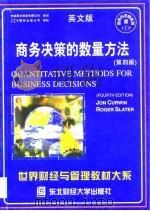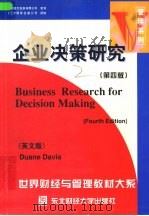《商务决策的数量方法 英文版 第4版》
| 作者 | (美)琼·科温(JonCurwin),(美)罗杰·斯莱特(R 编者 |
|---|---|
| 出版 | 沈阳:东北财经大学出版社 |
| 参考页数 | 667 |
| 出版时间 | 1998(求助前请核对) 目录预览 |
| ISBN号 | 7810441477 — 求助条款 |
| PDF编号 | 89937238(仅供预览,未存储实际文件) |
| 求助格式 | 扫描PDF(若分多册发行,每次仅能受理1册) |

Chapter 0 A refresher in basic mathematics1
1 Self-check tests2
2 Basic arithmetic10
3 Use of powers14
4 Basic algebra16
5 Graphs and more algebra18
6 Use of calculators25
7 Answers to recheck tests30
Part 1 Quantitatlv? Information37
Chapter 1 Data collection43
1.1 Population44
1.2 Sources of data46
1.3 Secondary data46
1.4 Primary data collection48
1.5 Asking questions54
1.6 Non-response to surveys61
1.7 Some alternative methods62
1.8 Market research63
1.9 Types of data64
1.10 Conclusions65
1.11 Problems67
Chapter 2 Presentation of data70
2.1 Tabulation of data71
2.2 Visual presentation75
2.3 Graphical representation85
2.4 Conclusions91
2.5 Problems91
Part 1 Conclusions97
Part 2 Descriptive statisties99
3.1 The mean,median and mode101
Chapter 3 Measures of location101
3.2 Other measures of location112
3.3 Conclusions115
3.4 Problems116
Chapter 4 Measures of dispersion120
4.1 The standard devlation120
4.2 Other measures of dispersion126
4.3 Relative measures of dispersion130
4.4 Variability in sample data131
4.5 Conclusions134
4.6 Problems134
4.7 Appendix139
Chapter 5 Index numbers140
5.1 The interpretation of an index number140
5.2 The construction of index numbers146
5.3 The weighting of index numbers151
5.4 The General Index of Retail Prices153
5.5 Conclusions155
5.6 Problems156
Part 2 Conclusions160
Part 3 Measuring uncertainty161
Chapter 6 Probability163
6.1 Basic concepts164
6.2 Definitions166
6.3 Basic relationships in probability168
6.4 Probability trees172
6.5 Expected values173
6.6 Decision trees175
6.7 BayesTheorem176
6.8 Markov Chains178
6.9 Conclusions181
6.10 Problems182
Chapter 7 Discrete probability distributions189
7.1 Uniform distribution190
7.2 Binomial distribution191
7.3 Poisson distribution197
7.4 Poisson approximation to the Binomial199
7.5 Conclusions199
7.6 Problems200
Chapter 8 The Normal distribution203
8.1 Characteristics of the Normal distribution203
8.2 The standard Normal distribution204
8.3 Normal approximation to the Binomial208
8.4 Normal approximation to the Poisson210
8.5 Combinations of varlables211
8.6 Central Limit Theorem213
8.7 Conclusions217
8.8 Problems217
Part 3 Conclusions221
Part 4 Statistical inference223
Chapter 9 Confidence intervals227
9.1 Statistical inference228
9.2 Inference on the population mean229
9.3 Inference on the population percentage237
9.4 The difference between independent samples240
9.5 The finite population correction factor243
9.6 The t-distribution245
9.7 Confidence interval for the median-large sample approximation249
9.9 Problems251
9.8 Conclusions251
Chapter 10 Significance testing257
10.1 Significance testing using confidence intervals258
10.2 Hypothesis testing for single samples259
10.3 One-sided significance tests265
10.4 Types of error270
10.5 Hypothesis testing with two samples273
10.6 Hypothesis testing with small samples276
10.7 Conclusions281
10.8 Problems282
Chapter 11 Non-parametric tests286
11.1 Chi-squared tests287
11.2 Mann-Whitney U test301
11.3 Wilcoxon test304
11.4 Runs test307
11.5 Conclusions308
11.6 Problems309
Part 4 Conclusions316
Part 5 Relating variables and predicting outcomes317
Chapter 12 Time series319
12.1 Time series models321
12.2 The trend324
12.3 The seasonal factors333
12.4 The cyclical factors338
12.5 The residual or random factor339
12.6 Predictions340
12.7 Exponentially weighted moving averages343
12.8 Summary and conclusions345
12.9 Problems347
Chapter 13 Correlation352
13.1 Scatter diagrams353
13.2 Cause and effect relationships355
13.3 Measuring linear association358
13.4 The coefficient of determination362
13.5 Measuring non-linear association364
13.6 Testing the significance of the correlation367
13.7 Conclusions370
13.8 Problems370
13.9 Derivation of the correlation coefficient376
13.10 Algebraic link between Spearman s and Pearson s coefficients376
Chapter 14 Regression378
14.1 Linear regression379
14.2 The graph of the regression line381
14.3 Predictions from the regression line382
14.4 Another regression line387
14.5 Interpretation388
14.6 Non-linear relationships389
14.7 Conclusions390
14.8 Problems390
14.9 Appendix394
Chapter 15 Multiple regression and correlation397
15.1 The basic two-variable model398
15.2 The effects of adding variables401
15.3 Assumptions and econometric problems404
15.4 Analysis of a multiple regression model409
15.5 Using multiple regression models413
15.6 Conclusions414
15.7 Problems414
Part 5 Conclusions420
Part 6 Modelling423
Chapter 16 The time value of money425
16.1 Interest:simple and compound426
16.2 Depreciation429
16.3 Present value431
16.4 The internal rate of return434
16.5 Incremental payments438
16.6 Annual percentage rate(APR)441
16.7 Conclusions442
16.8 Problems444
16.9 Appendix446
Chapter 17 Linear programming448
17.1 Definition of a feasible area449
17.2 The solution of a linear programming problem450
17.3 Special cases456
17.4 The value of resources459
17.5 Computer-based solutions461
17.7 Problems467
17.6 Conclusions467
Chapter 18 Networks473
18.1 Notation and construction474
18.2 The critical path477
18.3 Measures of float479
18.4 Gantt charts and managing resources481
18.5 Project time reduction482
18.6 Uncertainty486
18.7 Conclusions487
18.8 Problems487
Chapter 19 Modelling stock control and queues493
19.1 Introduction to the economic order quantity model493
19.2 Quantity discounts498
19.3 Non-zero lead time499
19.4 Introduction to modelling queues502
19.5 A model for a single queue503
19.6 Queues - modelling cost505
19.7 Modelling multi-channel queues507
19.8 Conclusions509
19.9 Problems510
19.10 Appendix - proof of EBQ511
Chapter 20 Simulation513
20.1 An introduction to simulation models514
20.2 Developing a simple simulation model515
20.3 Random event generation516
20.4 The construction of a simulation model520
20.5 Conclusions521
20.6 Problems521
Part 6 Conclusions523
Part 7 Mathematical background525
Chapter 21 Mathematical relationships527
21.1 Introduction to algebra528
21.2 Powers531
21.3 Arithmetic and geometric progressions532
21.4 Functions536
21.5 Conclusions551
21.6 Problems551
21.7 Proof of AP554
21.8 Proof of GP554
21.9 Proof of quadratic formula555
Chapter 22 Matrices556
22.1 What is a matrix?557
22.2 Matrix manipulation557
22.3 Solutions of simultaneous equations566
22.4 Leontief input-output analysis570
22.5 Conclusions573
22.6 Problems574
Chapter 23 Use of calculus577
23.1 Differentiation577
23.2 Economic applicationsⅠ584
23.3 Turning points587
23.4 Economic applicationsⅡ590
23.5 Further notes591
23.6 Integration594
23.7 Economic summary597
23.8 Functions of more than one variable597
23.9 Maximization and minimization subject to constraints601
23.10 Conclusions603
23.11 Problems604
Part 7 Conclusions609
Typical examination questions611
Appendices618
A Cumulative Binomial probabilities618
B Cumulative Poisson probabilities619
C Areas in the right-hand tail of the Normal distribution620
D Student s t critical points622
E χ2 critical values624
F Present value factors626
G Mann-Whitney test statistic628
H Wilcoxon test statistic631
I Runs test632
J Durbin-Watson statistic634
K Random number table636
L Loading MICROSTATS638
Answers to selected problems640
Index661
1998《商务决策的数量方法 英文版 第4版》由于是年代较久的资料都绝版了,几乎不可能购买到实物。如果大家为了学习确实需要,可向博主求助其电子版PDF文件(由(美)琼·科温(JonCurwin),(美)罗杰·斯莱特(R 1998 沈阳:东北财经大学出版社 出版的版本) 。对合法合规的求助,我会当即受理并将下载地址发送给你。
高度相关资料
-

- 软件工程实践者的研究方法 英文版·第4版
- 1999 北京:机械工业出版社
-

- 商法.第4版
- 1966.11 勁草書房
-

- 英文版 商业银行财务管理 (第五版)
- 1998年09月第1版 中国人民大学出版社
-

- 高效商务沟通 英文版·第7版
- 1998 北京:机械工业出版社
-

- 财务会计 英文版 第4版
- 1998 沈阳:东北财经大学出版社
-

- 商务沟通 英文版·第4版
- 1998 北京:机械工业出版社
-

- 质量控制统计方法 英文版 第7版
- 1999 北京:机械工业出版社
-

- 财务管理与政策 英文版 第11版
- 1998 北京:清华大学出版社
-

- 商务沟通 英文版 第11版
- 1998 沈阳:东北财经大学出版社
-

- 商务经济统计方法 英文版·第9版
- 1998 北京:机械工业出版社
-

- 决策与控制会计 英文版·第2版
- 1998 沈阳:东北财经大学出版社;McGraw-Hill出版公司
-

- 机械加工
- 1984 北京:国防工业出版社
-

- 企业决策研究 英文版 第4版
- 1998 沈阳:东北财经大学出版社
提示:百度云已更名为百度网盘(百度盘),天翼云盘、微盘下载地址……暂未提供。➥ PDF文字可复制化或转WORD

